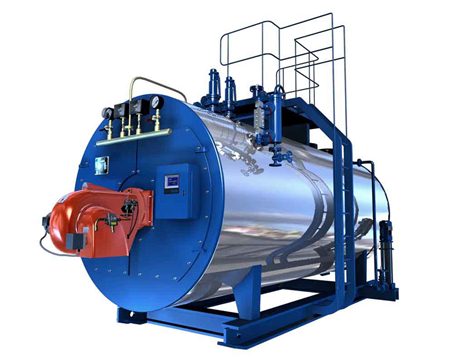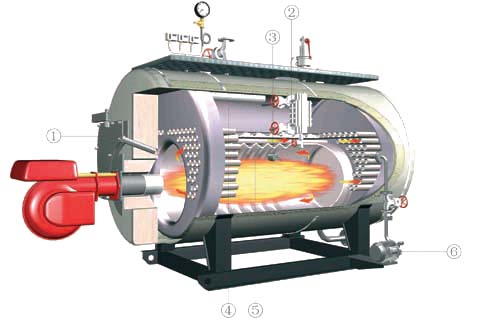
Eventually the gases flow through a stack and into the atmosphere. As long as fuel and air are both available to continue the combustion process, heat will be generated.
Boilers are manufactured in many different sizes and configurations depending on the characteristics of the fuel, the specified heating output, and the required emissions controls. Some boilers are only capable of producing hot water, while others are designed to produce steam. Various studies have been conducted to estimate the number of boilers in the United States, but no data source provides a complete representation of the existing boiler population.
In the United States, boilers are typically designed and constructed as either power or heating boilers in accordance with applicable requirements adopted by the American Society of Mechanical Engineers (ASME). Rules for power boilers are provided in Sect. I of the ASME Boiler and Pressure Vessel Code.2 These rules apply to steam boilers that operate above 15 psig and hot water boilers that operate above 160 psig or 250°F. Common design pressures are 150, 200, 250, and 300 psig, but higher pressures are possible. For example, boilers for certain pulp and paper industry applications are now designed for pressures as high as 1,500 psig. Corresponding rules for heating boilers are provided in Sect. IV.4 According to these rules, heating boilers that produce hot water are not allowed to operate above 160 psig or at temperatures above 250°F at or near the boiler outlet. Additional rules limit heating boilers that produce steam to a maximum operating pressure of 15 psig.
Many boilers with heat input capacities more than 250 million British thermal units per hour (MBtu/h) are classified as utility boilers because they are used at power plants to produce electricity.
Some boilers of this size are also used at paper mills and institutions and for other industrial applications. Smaller boilers with less capacity are categorized as ICI boilers. Industrial boilers are used extensively by the chemical, food processing, paper, and petroleum industries. They have heat input capacities up to and sometimes more than 250 MBtu/h. Commercial and institutional boilers are used in many other applications including commercial businesses, office buildings, apartments, hotels, restaurants, hospitals, schools, museums, government buildings, and airports.
In the past when emissions were less regulated, choosing the right boiler and combustion equipment for a particular application generally involved matching the process requirements with the boiler. output capacity. Proper sizing and selection required knowledge of the peak process requirements and an understanding of the load profile. This boiler selection philosophy emphasized energy conversion at the lowest possible cost. Reduced emphasis was placed on controlling emissions. Public concerns about air and water quality and enactment of federal, state, and local regulations have shifted this emphasis. The current design objective is to provide low-cost energy with an acceptable impact on the environment. As discussed in an engineering manual published by ABMA, control of PM, NOx, CO, and SO2 emissions is now a significant consideration in the overall boiler and combustion equipment design and selection process.
TYPES OF ICI BOILERS
we will focus primarily on a broad class of steam and hot water generating units known as ICI boilers. Because of differences in their features and characteristics, ICI boilers can be classified in at least three ways.
. Boilers are commonly subdivided into watertube or firetube units. These designations reflect the way the water and combustion gases are designed to pass through the unit.
. Boilers are sometimes classified by their heat sources. For example, boilers are often referred to as oil-fired, gas-fired, coal-fired, or solid fuel-fired boilers. Coal-fired boilers can be further divided based on the equipment used to fire the boiler. The three major coal-fired boiler subclasses are pulverized-coal (PC) fired, stoker-fired, and fluidized-bed combustion (FBC) boilers.
. Boilers are occasionally distinguished by their method of fabrication. Packaged boilers are assembled in a factory, mounted on a skid, and transported to the site as one package ready for hookup to auxiliary piping. Shop-assembled boilers are built up from a number of individual pieces or subassemblies. After these parts are aligned, connected, and tested, the entire unit is shipped to the site in one piece. Field-erected boilers are too large to transport as an entire assembly. They are constructed at the site from a series of individual components. Sometimes these components require special transportation and lifting considerations because of their size and weight.
The basic purpose of any ICI boiler is to convert the chemical energy in fuel into thermal energy that can be used to generate steam or hot water. Inside the combustion chamber, two fundamental processes must occur to achieve this objective. First, the fuel must be mixed with sufficient oxygen to allow sustained combustion. The heated gases produced by the combustion process must then transfer the thermal energy to a fluid such as water or steam. Various components inside the boiler are required to promote efficient combustion and heat transfer. Their design depends on factors such as the type of fuel and the method selected to transfer thermal energy.
The ICI boilers are manufactured in a wide range of sizes to burn coal, oil, natural gas, biomass, and RDFs as well as other fuels and fuel combinations. Most ICI boilers are classified as either watertube or firetube boilers, but other designs such as cast iron, coil-type, and tubeless (steel shell) boilers are also produced. Descriptions of some of the more typical boiler designs are presented below. Additional details about ICI boilers and their design, construction, and operation are available from other sources.
Firetube Boilers
Generally, the heat input capacities for firetube boilers are limited to 50 MBtu/h or less,5 but in recent years the size of firetube boilers has increased.
Firetube boilers are subdivided into three groups. Horizontal return tubular (HRT) boilers typically have horizontal, self-contained firetubes with a separate combustion chamber. Scotch, Scotch marine, or shell boilers have the firetubes and combustion chamber housed within the same shell. Firebox boilers have a water-jacketed firebox and employ, at most, three passes of combustion gases.
Most modern firetube boilers have cylindrical outer shells with a small round combustion chamber located inside the bottom of the shell. Depending on construction details, these boilers have tubes configured in either one, two, three, or four pass arrangements. Because the design of firetube boilers is simple, they are easy to construct in a shop and can be shipped fully assembled as a package unit.
Watertube Boilers
Newer boilers have tubes with complex and diverse bends. Because the pressure is confined inside the tubes, watertube boilers can be fabricated in larger sizes and used for higher-pressure applications. Small watertube boilers, which have one and sometimes two burners, are generally fabricated and supplied as packaged units. Because of their size and weight, large watertube boilers are often fabricated in pieces and assembled in the field.
Almost any solid, liquid, or gaseous fuel can be burned in a watertube boiler. Common fuels include coal, oil, natural gas, biomass, and other solid fuels such as municipal solid waste (MSW), tire-derived fuel (TDF), and RDF. Designs of watertube boilers that burn these fuels can be significantly different.
Coal-fired watertube boilers are classified into three major categories: stoker-fired units, PC-fired units, and FBC boilers.
Stoker-fired boilers include a mechanical system that is designed to feed solid fuel into the boiler. These stokers are designed to support the combustion process and to remove the ash as it accumulates. All stokers operate similarly. They use both undergrate and overfire air to burn fuel located on a grate.
During operation, finely ground coal is mixed with primary combustion air and fed to the burner or burners where it ignites. Secondary combustion air is then supplied to complete the combustion process.
Depending on the location of the burners and the direction of coal injection, PC-fired boilers can be classified as single- or opposed-wall, tangential (corner), or cyclone boilers. Discussions about burners for PC-fired boilers are Depending on whether the ash is removed in a solid or molten state, PC-fired boilers are also classified as dry or wet bottom. Opposed-wall boilers are usually much larger than 250-MBtu/h heat input capacity. They are used primarily for utility but may be suitable for certain industrial applications. Coal burned in cyclone boilers is crushed rather than pulverized.
The FBC boilers are capable of burning a wide range of solid fuels. In this method of combustion, fuel is burned in a bed of hot incombustible particles suspended by an upward flow of fluidizing gas such as air. Fuels that contain a high concentration of ash, sulfur, and nitrogen can be burned efficiently while meeting stringent emission limitations. When sulfur capture is not required, inert materials such as alumina may be added to supplement the fuel ash and maintain the bed. In applications where sulfur capture is required, limestone is incorporated into the bed and used as the sorbent. The FBC boilers are categorized as either atmospheric or pressurized units. Atmospheric FBC boilers are further divided into bubbling-bed and circulating-bed units; the fundamental difference between these two is the fluidization velocity. Coal is often burned in FBC boilers, but it is also possible to burn biomass and other solid fuels. Natural gas or fuel oil is used primarily as a start-up fuel to preheat the fluidized bed or as an auxiliary fuel when additional heat is required.
Combustion of other solid fuels, including MSW and RDF, is often accomplished in a boiler with a stoker system. Fuels of this type generally have specially designed feed systems for supplying and distributing the fuel particles. Boilers that burn these fuels are also specially designed to interface with the fuel feed system and to burn the fuel as efficiently as possible. Many boilers that burn solid nonfossil fuels have some type of fossil fuel firing capability. These auxiliary fuels are used during start-up operations, as a supplementary fuel, or alone when the primary fuel is unavailable.
Nonfossil gaseous fuels that are rich in CO and hydrogen can also be burned in watertube boilers. These fuels can be generated by the partial combustion of biomass using gasification or pyrolysis techniques.
Fuel oil-fired and natural gas-fired watertube package boilers are subdivided into three classes based on the geometry of the tubes. The .A. design has two small lower drums and a larger upper drum for steam-water separation. In the .D. design, which is the most common, the unit has two drums and a large-volume combustion chamber. The orientation of the tubes in a .D. boiler creates either a left- or right-handed configuration. For the .O. design, the boiler tube configuration exposes the least amount of tube surface to radiant heat. Rental units are often boilers because their symmetry is a benefit in transportation.



